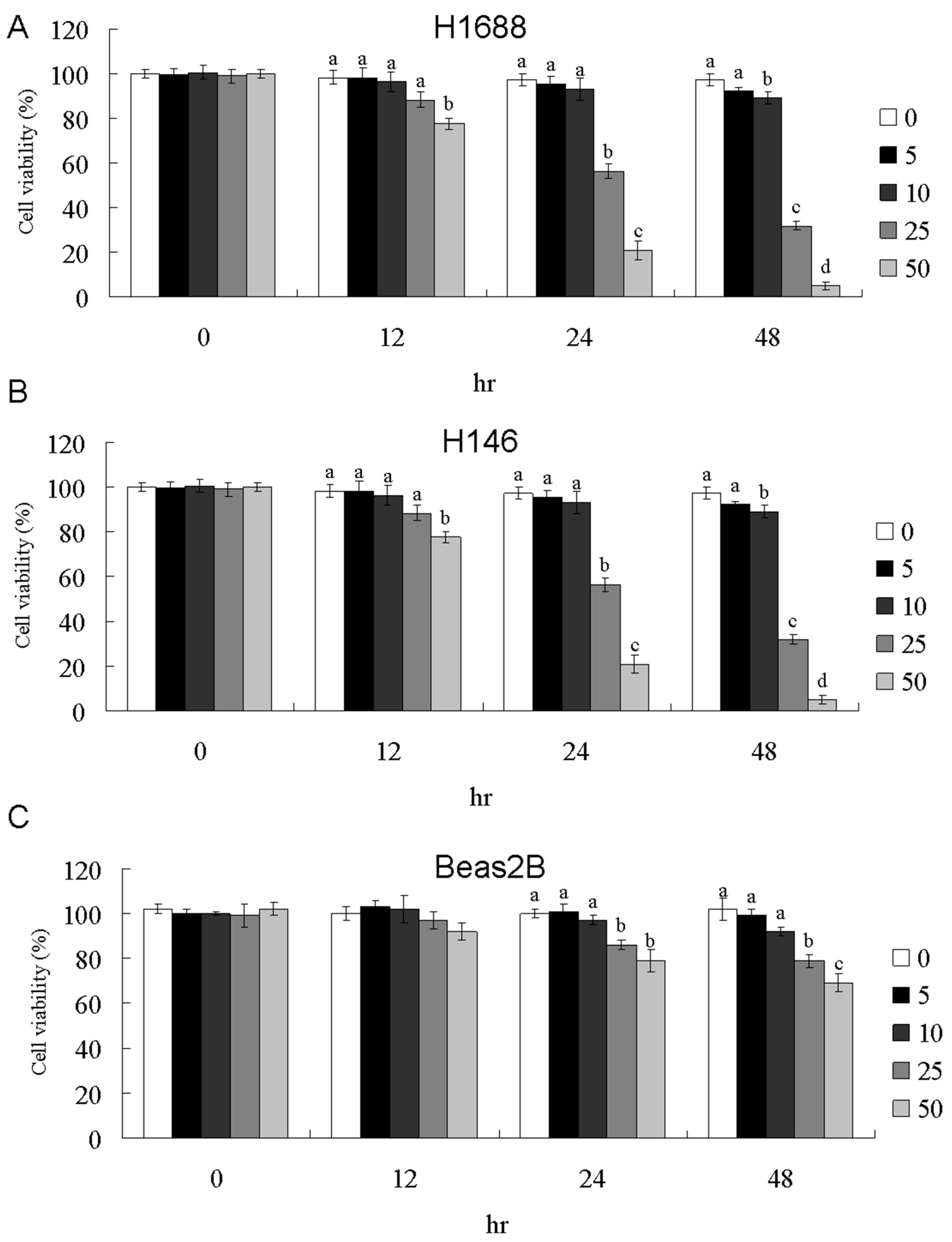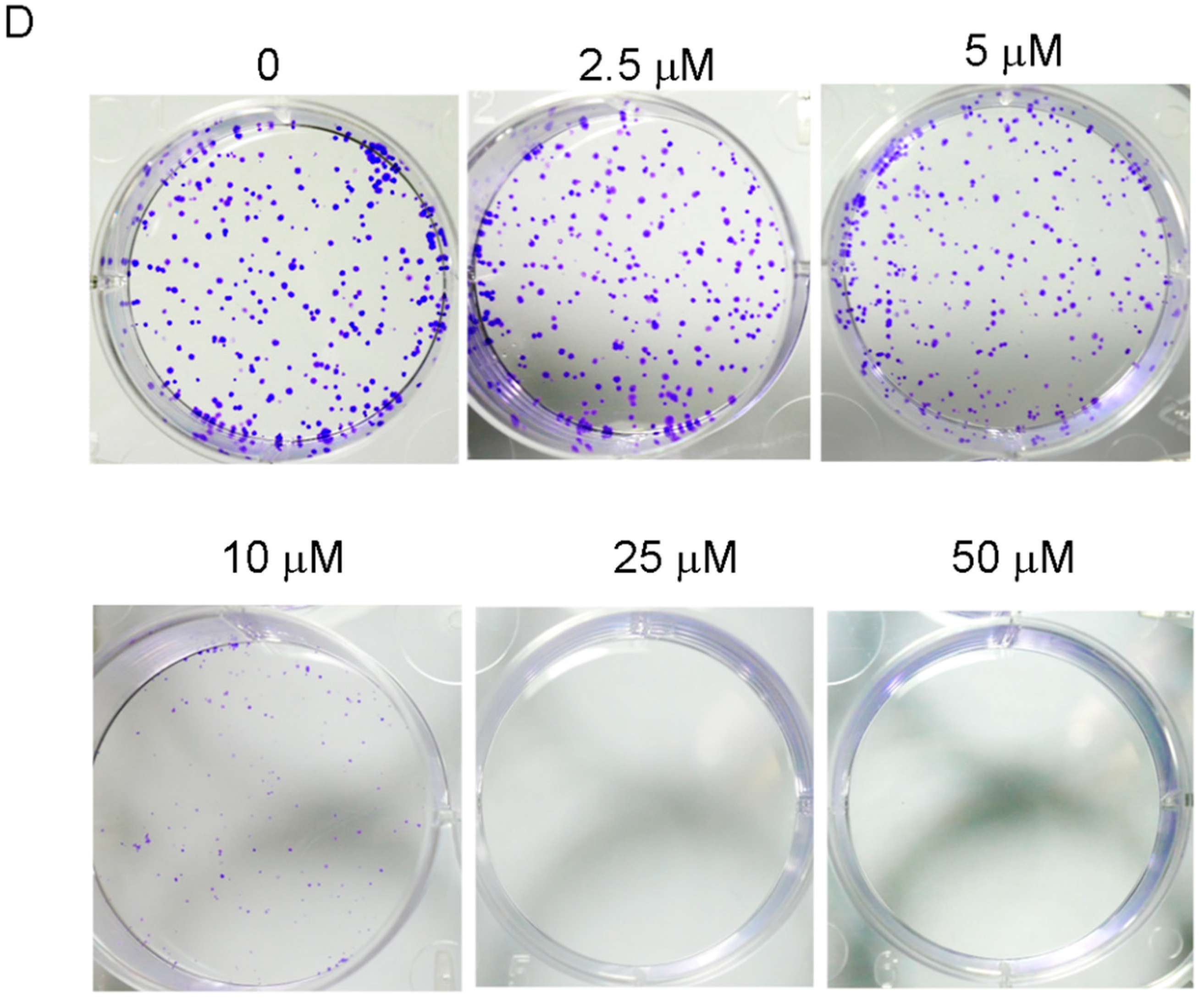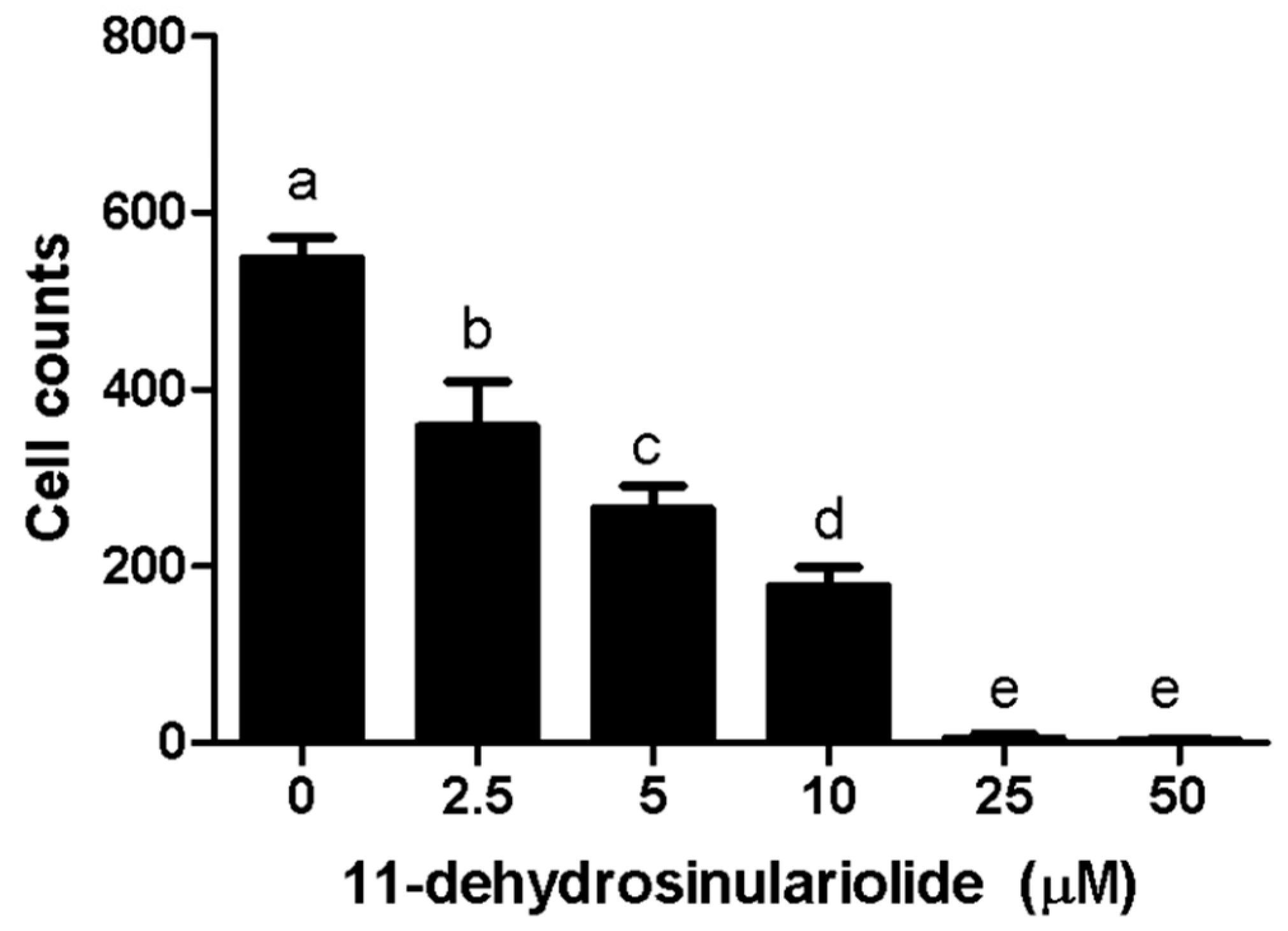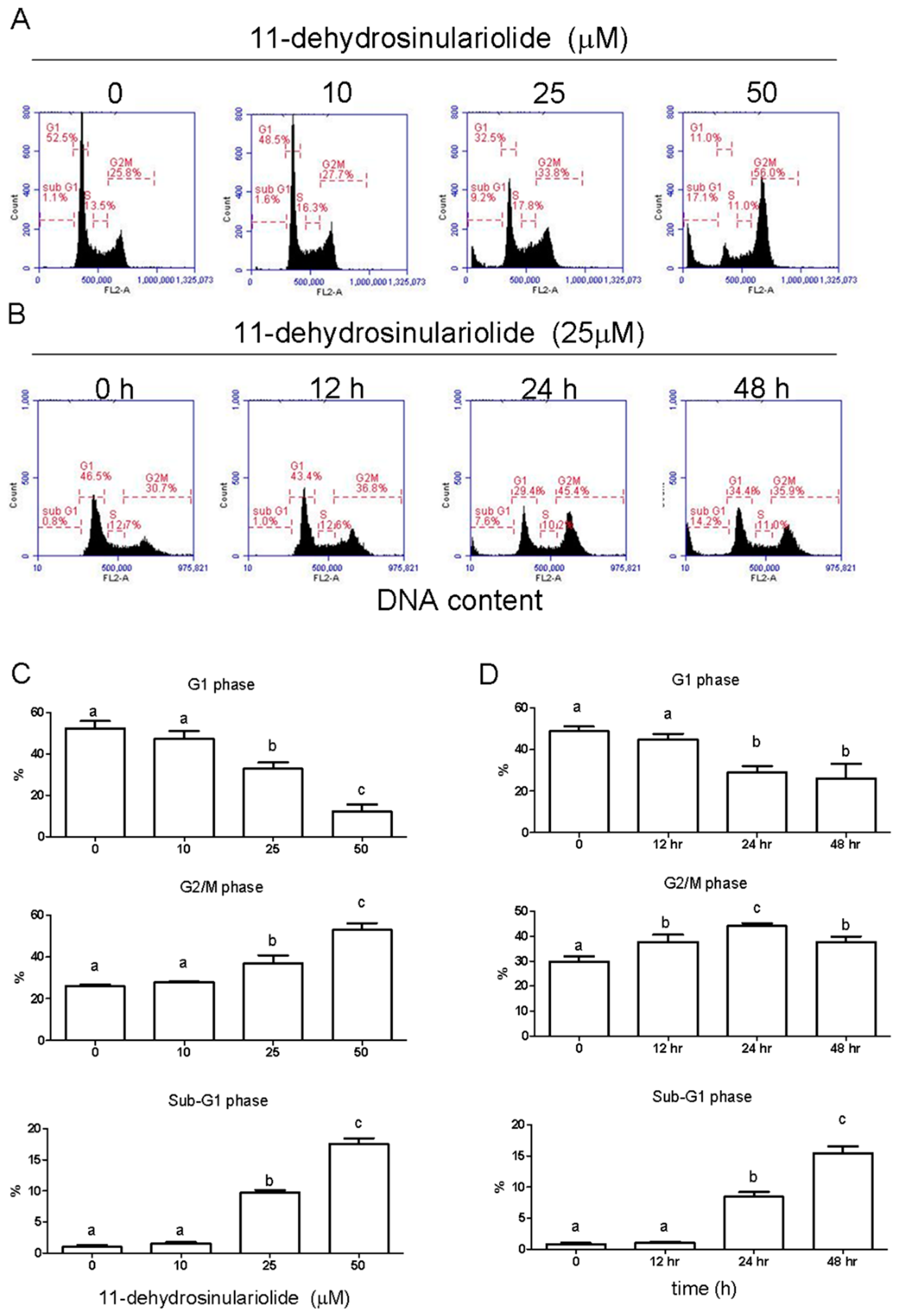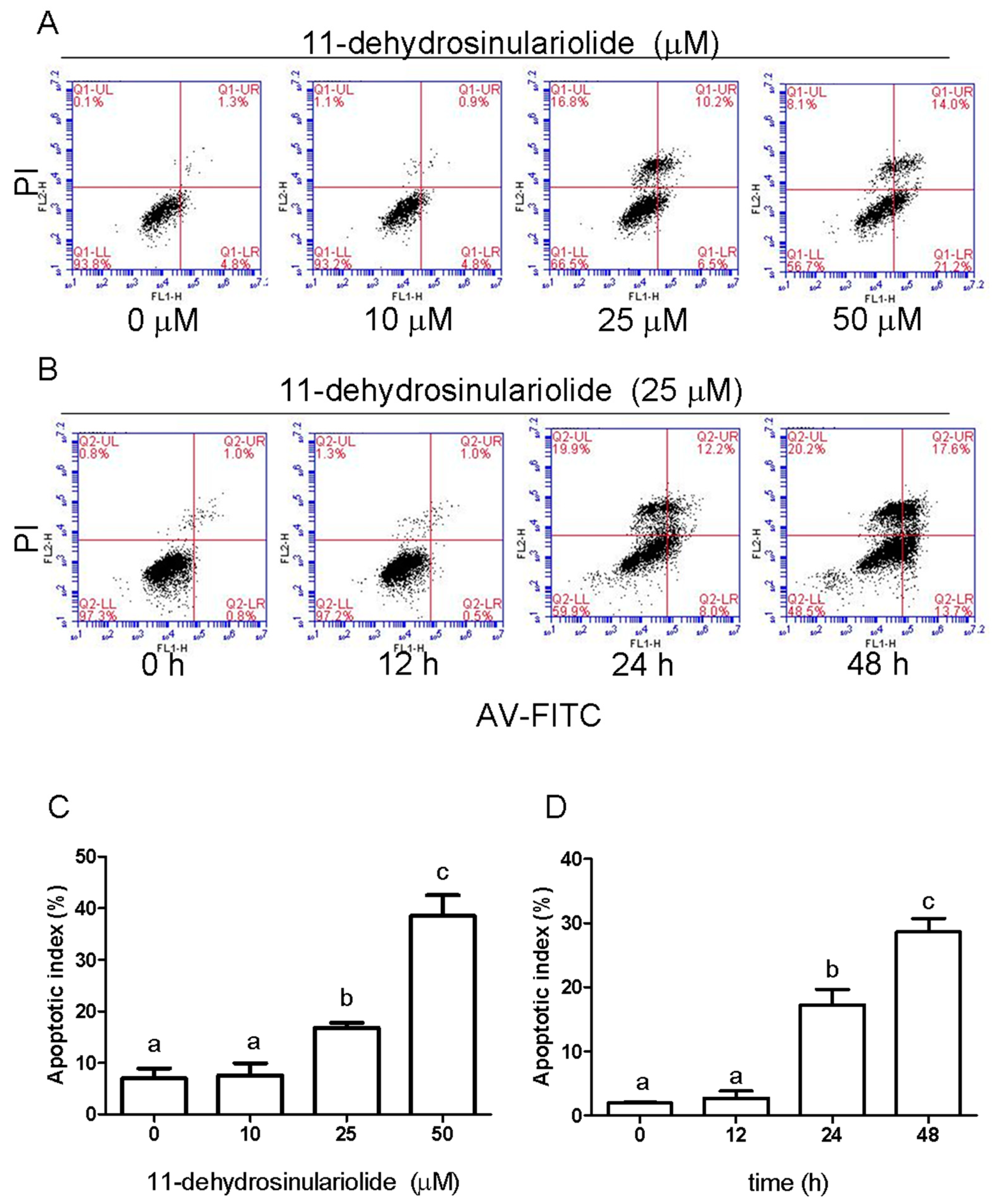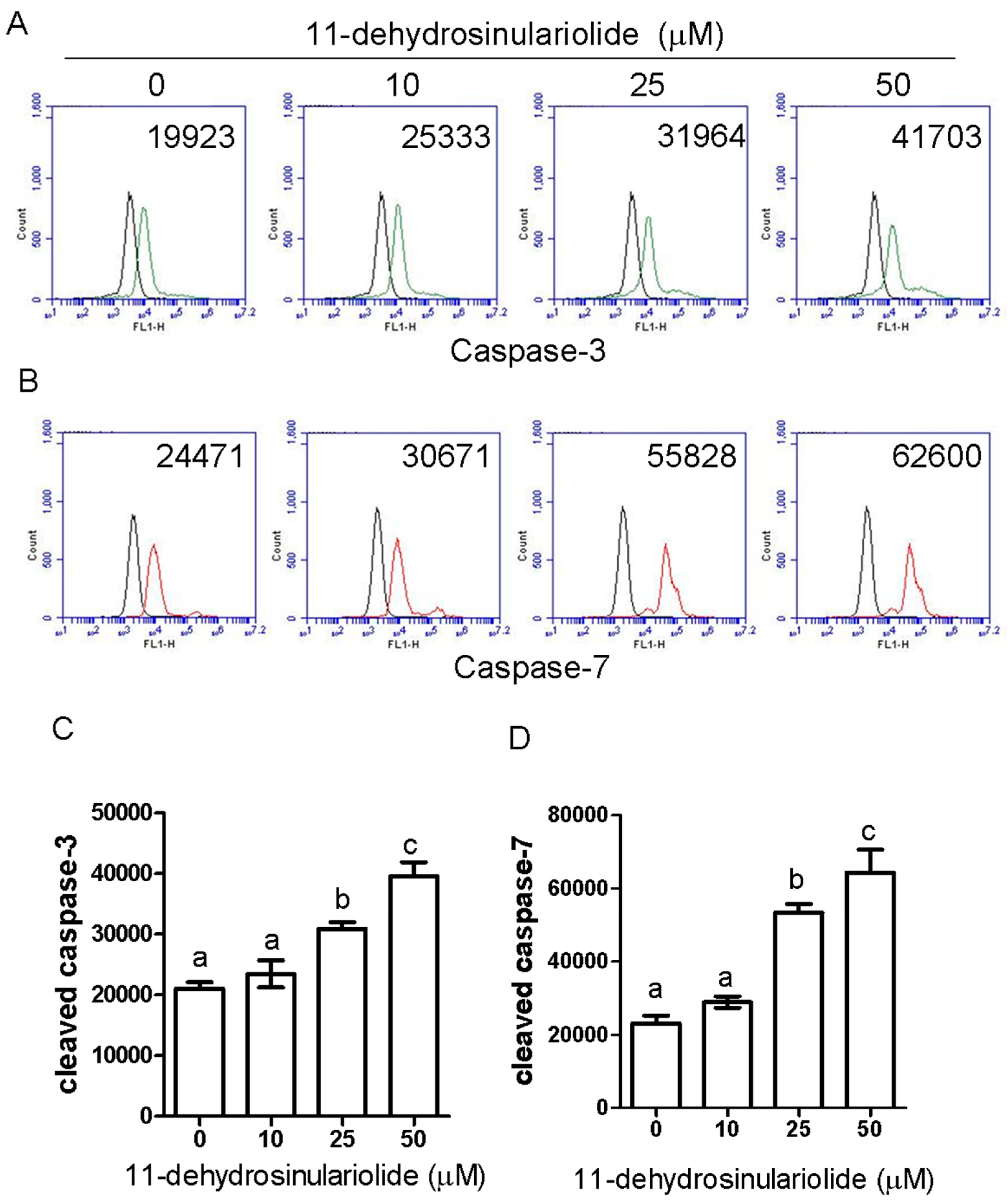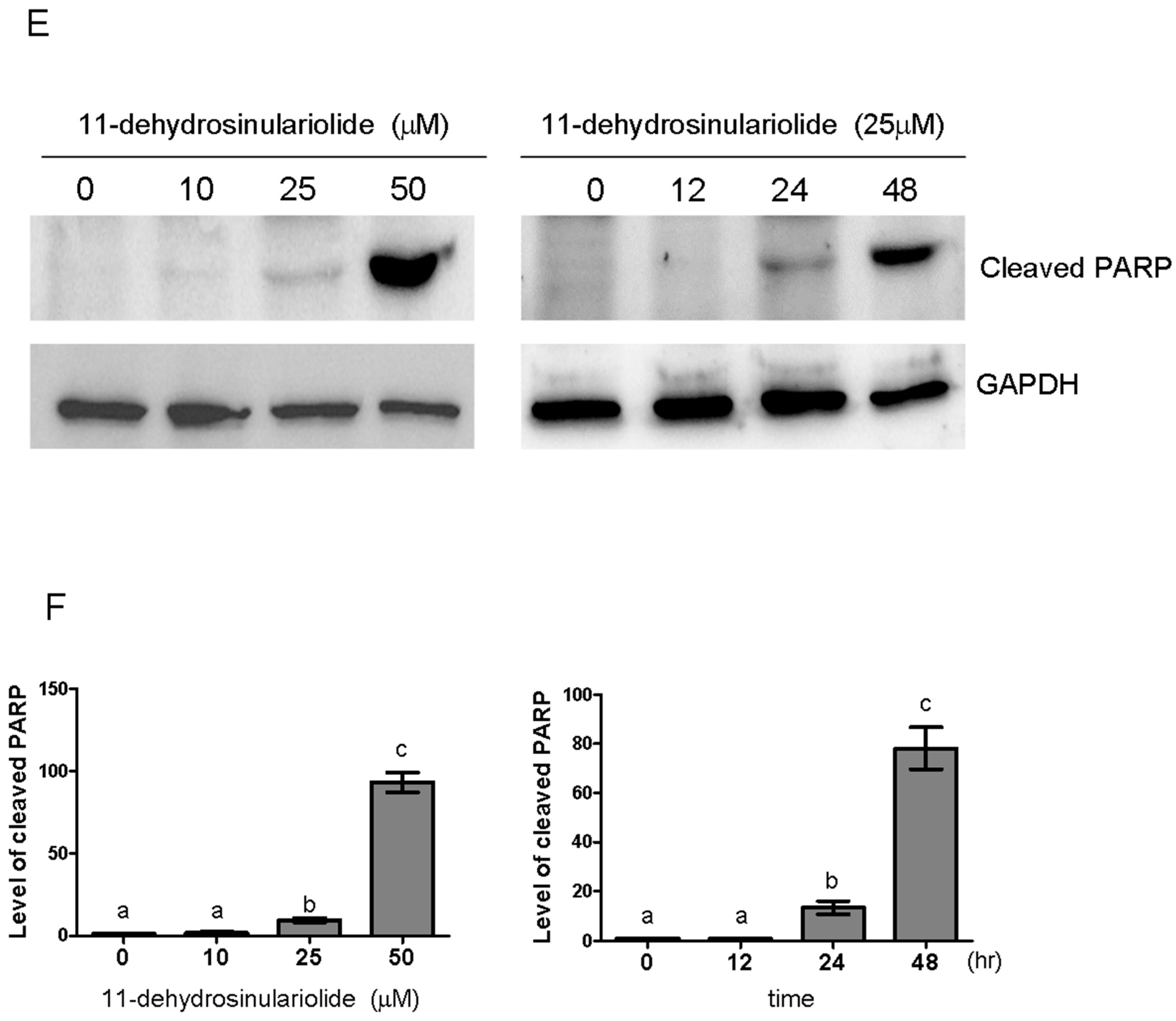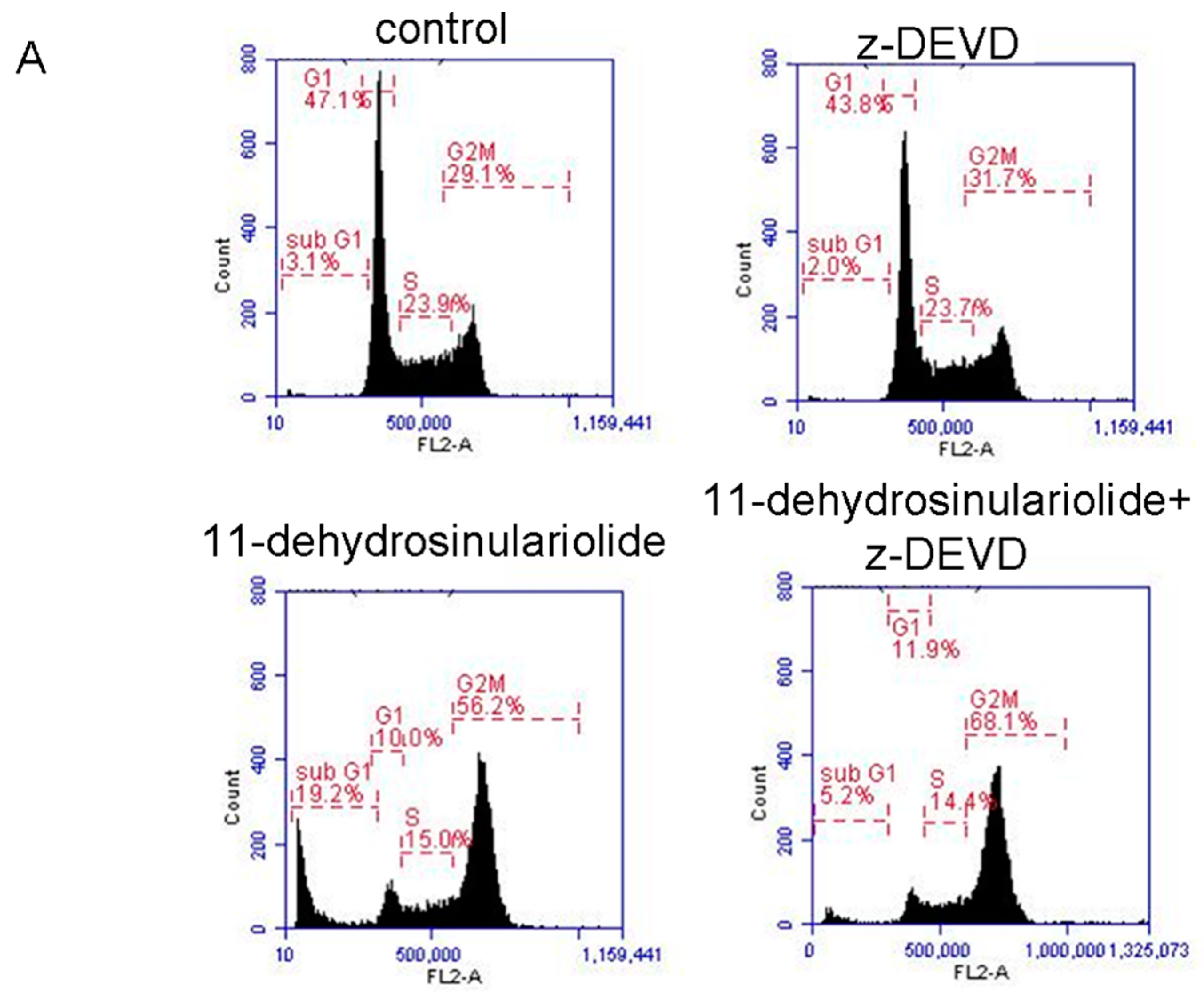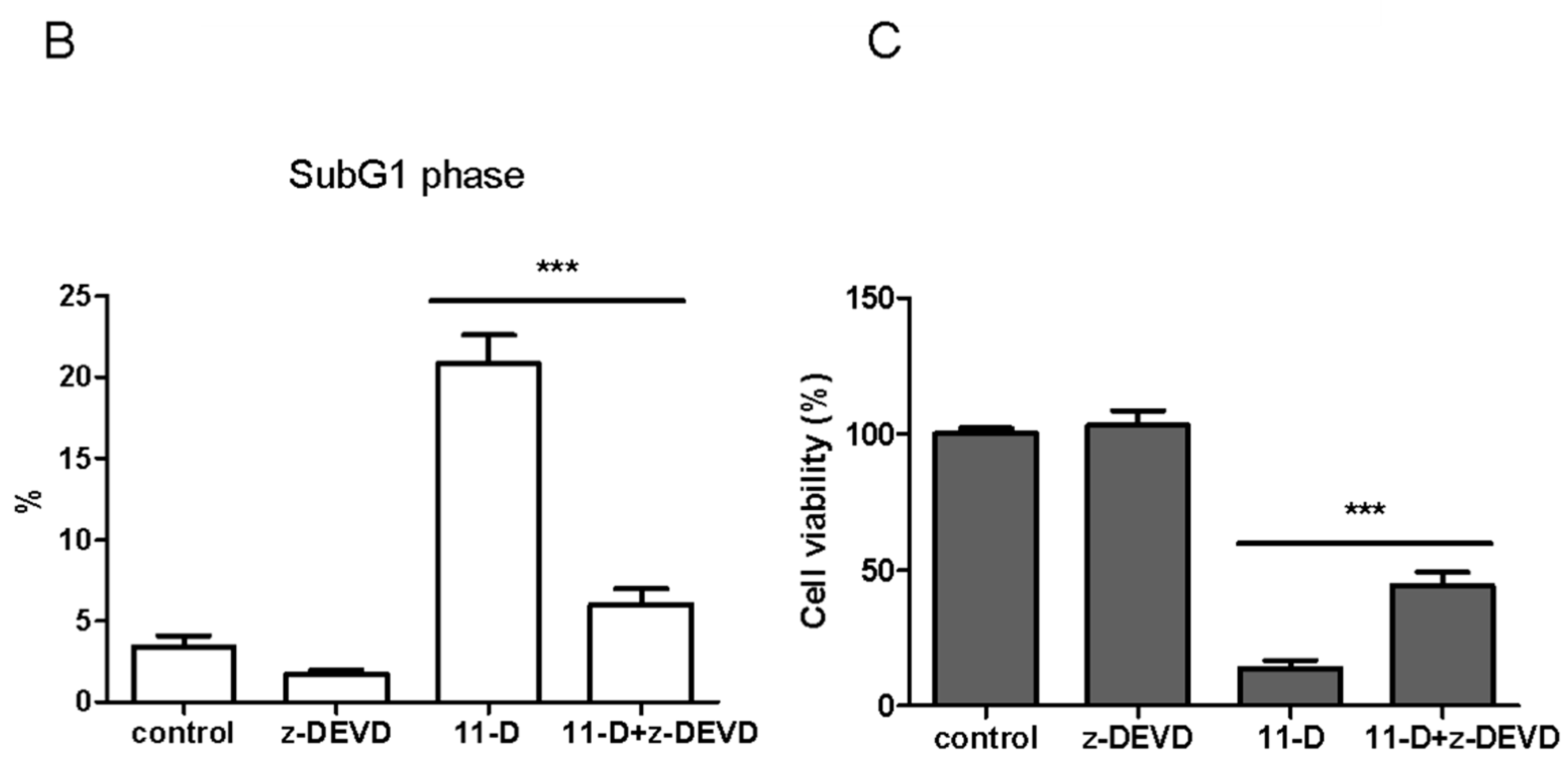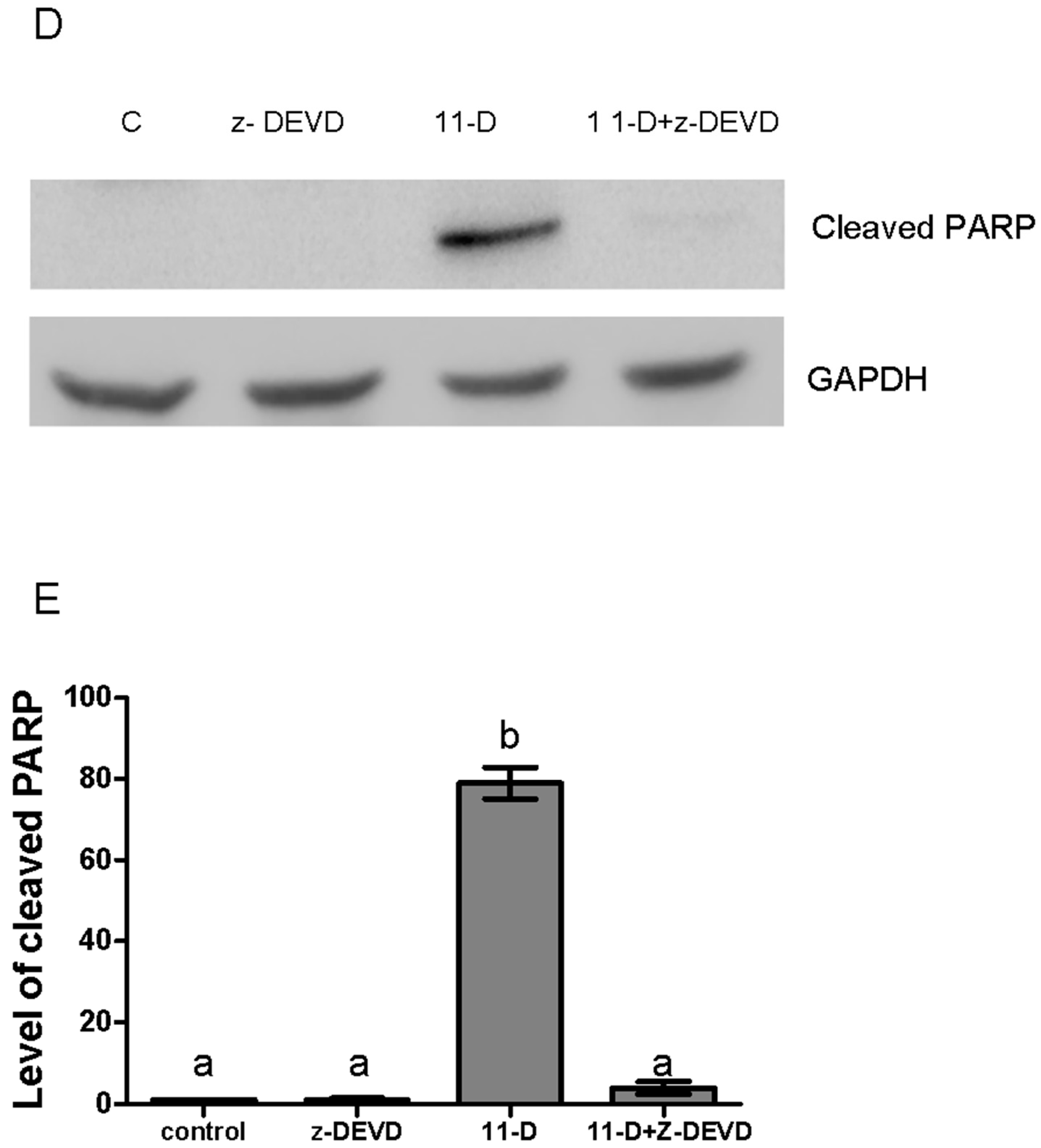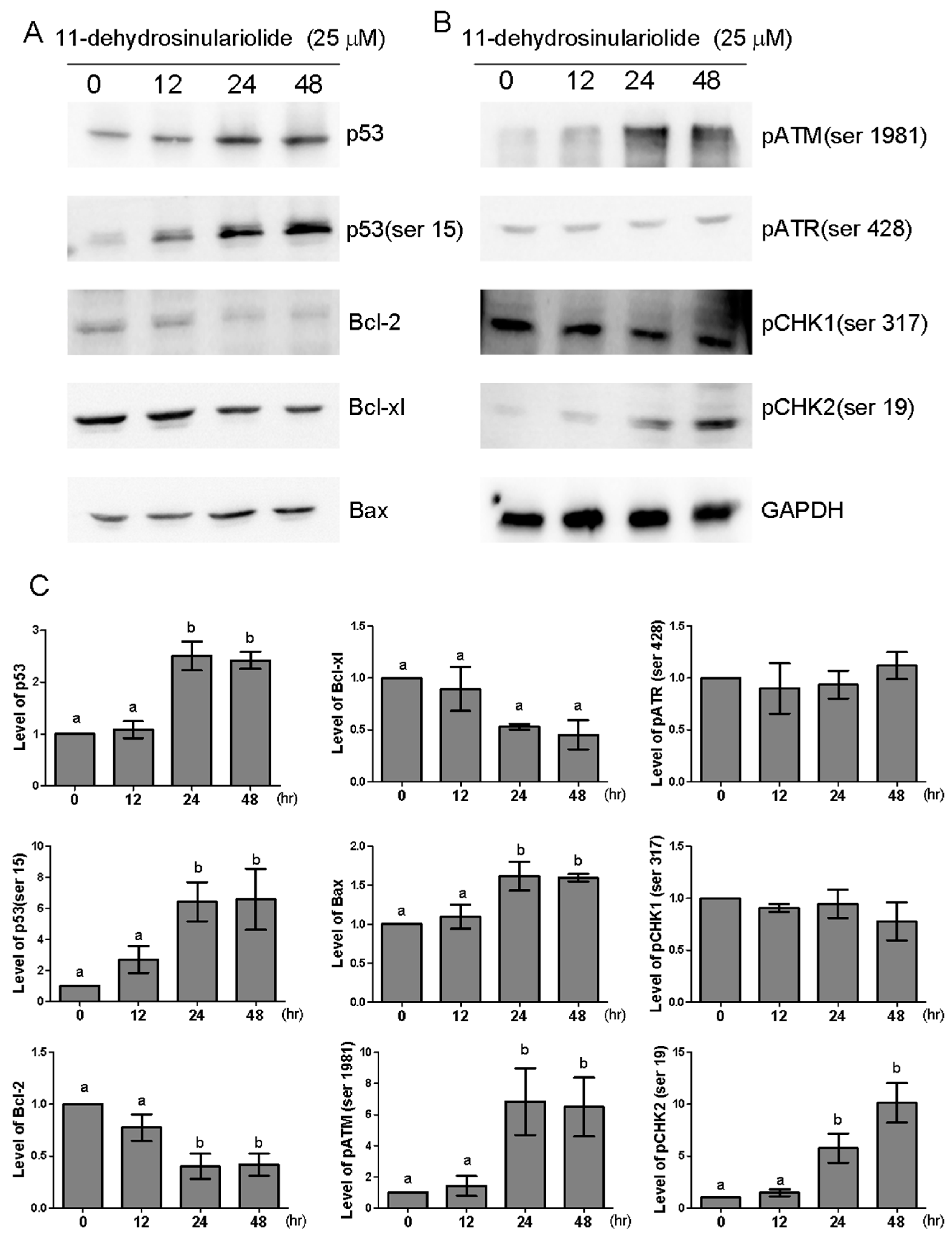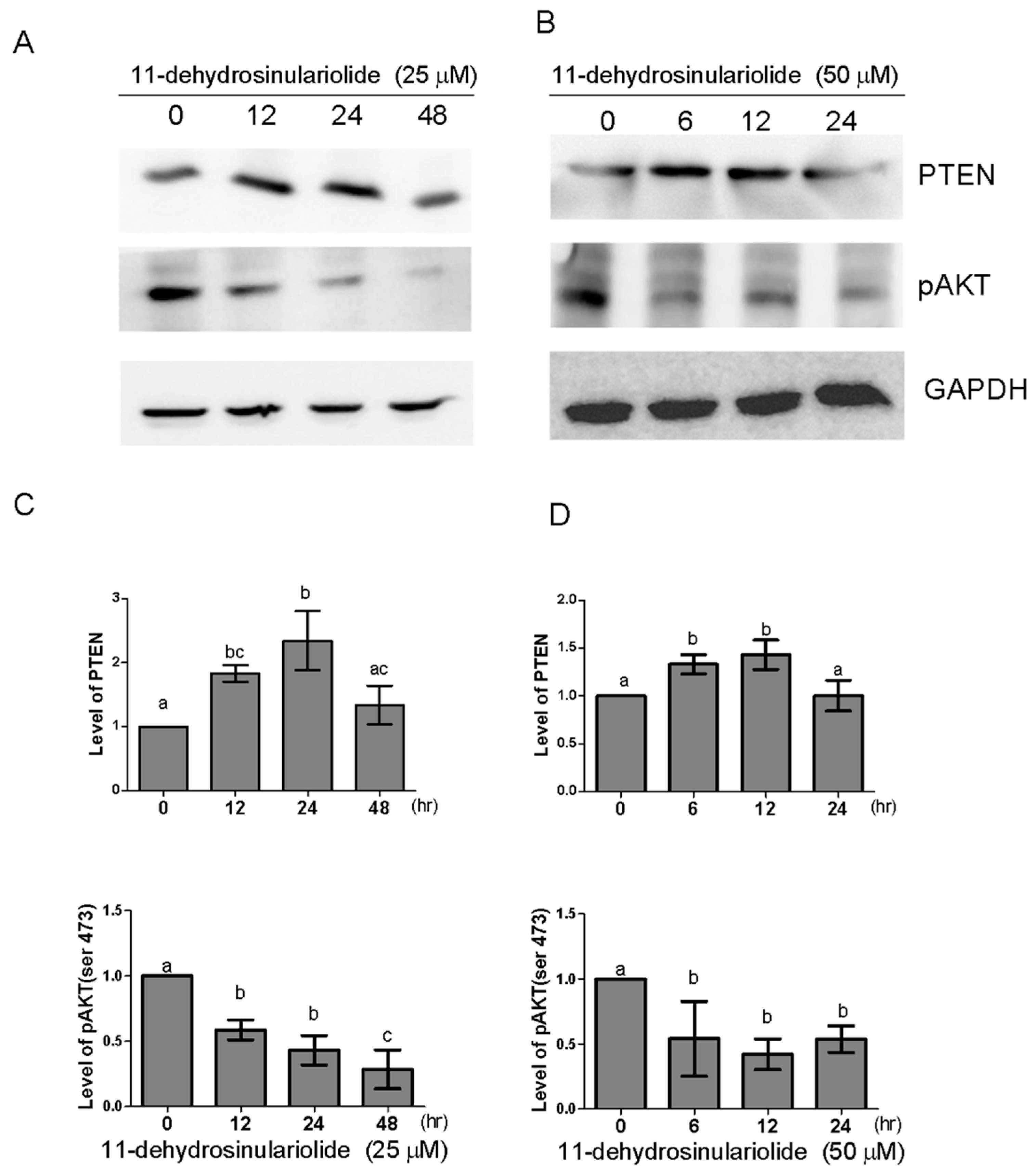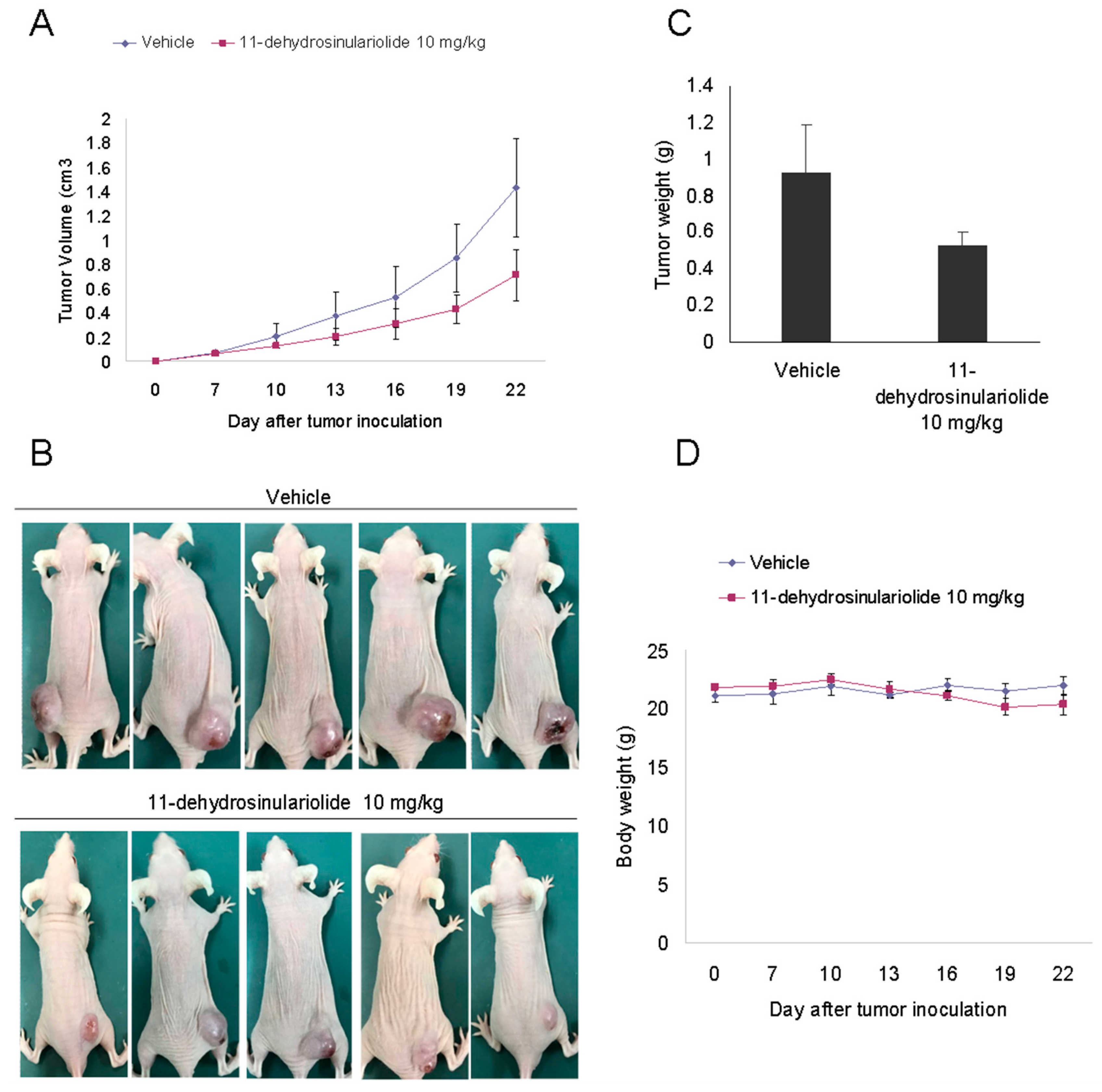1. Introduction
Lung cancer is the most common cancer and exhibits the highest mortality rate among all cancer types in the world [
1]. According to the specific histopathological features of the disease, the two major types of lung cancer are small cell lung cancer (SCLC) and nonsmall cell lung cancer (NSCLC). SCLC is the most aggressive form of lung cancer and accounts for 10%~15% of all lung cancers [
2]. Clinically, SCLC grows rapidly and is more easily metastasized to other parts of the body. To reduce the high mortality rate, many researchers have focused on lung cancer prevention methods, as well as early detection and more effective treatments [
3]. Although improvements have been made in lung cancer diagnosis and prevention, the effectiveness of the available treatment options remains limited. According to the American Cancer Society guidelines [
4], chemotherapy is often part of SCLC treatment, and cisplatin, etoposide, carboplatin, and irinotecan are the most commonly used drugs. However, the current SCLC chemotherapy is not effective [
5], and thus the potential mechanism underlying the development of lung cancer tumors has been sought to identify new treatment options.
Recently, several metabolites derived from marine organisms have become potential and valuable sources of anticancer drug candidates. 11-Dehydrosinulariolide, which is a cembranolide analog isolated from the cultured soft coral
Sinularia flexibilis, showed several bioactivities [
6,
7,
8]. 11-Dehydrosinulariolide could treat Parkinson’s disease through its anti-apoptotic and anti-inflammatory action via PI3K signaling [
6]. 11-Dehydrosinulariolide has antiapoptotic and anti-inflammatory effects to improve functional recovery after spinal cord injury [
7]. Recent reports have indicated that 11-dehydrosinulariolide exerts its antitumor effects by either caspase-dependent mitochondrial dysfunction-related or endoplasmic reticulum (ER) stress pathways in human oral squamous cell carcinoma cells Ca9-22 [
8] and in human melanoma cells A2058 [
9].
Although these findings demonstrate the anticancer activity of 11-dehydrosinulariolide, the underlying molecular mechanisms of the antitumor activity of 11-dehydrosinulariolide remain unclear. Additionally, there is no report on the antitumor effects of 11-dehydrosinulariolide against human small cell lung cancer (SCLC) cells. Hence, the aim of this study was to evaluate the effect of 11-dehydrosinulariolide on the antiproliferation of SCLC cells in vitro and in vivo and to investigate the potential molecular mechanisms. Particularly, we sought insights into the mechanism of action of 11-dehydrosinulariolide as well as its effects on cell proliferation, the cell cycle distribution, apoptosis, and expression levels of several cell cycle- and apoptosis-related proteins.
3. Discussion
11-Dehydrosinulariolide, a marine-derived terpenoid, has shown several bioactivities [
6,
7,
8]. Chen et al. [
6] reported that 11-dehydrosinulariolide suppressed 6-hydroxydopamine-induced cytotoxicity and apoptosis in a human neuroblastoma cell line, SH-SY5Y, and reduced the expression of inducible NO synthase (iNOS) and cyclooxygenase-2 (COX-2) proteins in lipopolysaccharide-stimulated macrophage cells. Chen et al. [
7] showed that 11-dehydrosinulariolide has anti-apoptotic and anti-inflammatory effects through PI3K/Akt-dependent CREB activation and M2 microglia polarization, respectively. Liu et al. [
8] reported that 11-dehydrosinulariolide induced cytotoxicity in Ca9-22 cells through both ATF6 and PERK-eIF2α-ATF4-CHOP apoptosis-inducing pathways. However, the anticancer effects of 11-dehydrosinulariolide on SCLC have yet to be evaluated. In the present study, we investigated the potential anticancer effects of 11-dehydrosinulariolide on H1688 SCLC cells and the underlying mechanisms.
Recently, increasing evidence has revealed that the dysregulation of apoptosis is related to carcinogenesis [
19]. Therefore, it was pointed out that the therapeutic efficacy of chemotherapeutic agents depends on the ability of tumor cells to respond to apoptosis [
20]. 11-Dehydrosinulariolide has been shown to induce caspase-dependent apoptosis in human oral squamous cell carcinoma cells [
8,
21] and human melanoma cells [
9]. In our present study, the presence of apoptotic cells (annexin V+), activated forms of caspase-7 and caspase-3, and PARP cleavage indicated that apoptosis was involved in 11-dehydrosinulariolide-induced SCLC cell death. However, it is worth noting that in the oral carcinoma and melanoma cell lines, the concentration of 11-dehydrosinulariolide that induced apoptosis at 24 h. was 1.5–6 µg/mL (approximately 4.5–8 µM). [
8,
9,
21] However, our study found that 10 µM 11-dehydrosinulariolide did not significantly induce apoptosis at 24 h., but a concentration above 25 µM is needed to induce apoptosis in SCLC H1688 cells. Therefore, it is important to further explore the detailed mechanism of 11-dehydrosinulariolide and explain why different cells have different effects.
Cell cycle arrest is a common cause of cell growth inhibition [
22]. Unlike previous studies, our study, for the first time, found that 11-dehydrosinulariolide can induce G2/M arrest in SCLC cells. Additionally, ATM plays an important role in the activation of cell cycle checkpoints [
23]. ATM is rapidly and specifically activated in response to not only this activation but also to damage induced by other cellular stresses [
24,
25,
26]. When DNA damage occurs, activated ATM can regulate the phosphorylation status and, thus, the activity of Chk2, which subsequently induces G2/M cell cycle arrest by decreasing the protein expression of cdc25c [
27]. In the present study, we first found that 11-dehydrosinulariolide activated ATM and Chk2, suggesting that the mechanisms responsible for the effects of 11-dehydrosinulariolide on G2/M phase arrest may be related to the regulation of the ATM-Chk2 signaling pathway. However, the detailed mechanism still requires more experiments to prove.
A previous study reported that ATM can phosphorylate Chk2 [
28], which is involved in p53 activation [
16], indicating that ATM and Chk2 are part of the pathway that leads to p53 activation. The level of p53 is controlled by the Mdm2 protein, which degrades p53 soon after synthesis [
29]. When cells are subjected to certain types of genotoxic stress, ATM or Chk2 can phosphorylate p53 at multiple sites, thereby preventing Mdm2-mediated degradation [
30,
31,
32]. Additionally, accumulation of these p53 target genes may contribute to the release of cytochrome c from the mitochondria, resulting in the activation of caspase-3 and caspase-7 by inducing the expression of proapoptotic genes, including Bax [
12]. In the present study, our data showed that the expression of p53 and p53 (Ser15) was increased from 24 to 48 h of 11-dehydrosinulariolide exposure, and Bax expression was increased after 24 h of 11-dehydrosinulariolide exposure. Additionally, the levels of p-ATM (Ser1981) and p-Chk2 (Ser19) were increased during 11-dehydrosinulariolide treatment. This result parallels the rise in p-p53 (Ser15). Thus, these data suggest that 11-dehydrosinulariolide-induced apoptosis of SCLC cancer cells may be associated with the activation of the DNA damage-sensing kinases, ATM and Chk2, leading to the accumulation of p53, which, in turn, transactivates the proapoptotic Bax signaling pathway.
Bcl-2 proteins are a family of proteins involved in the response to apoptosis. Some of these proteins (such as bcl-2 and bcl-XL) are anti-apoptotic, while others (such as Bad, Bax or Bid) are pro-apoptotic and have been reported to play a pivotal role in regulating cell life and death [
33]. Therefore, the balance between the anti-apoptotic and pro-apoptotic Bcl-2 family protein expression levels is important for the fate of the cells. Similar to previous results in oral carcinoma and melanoma cell lines [
8,
9], our data also revealed that the protein expression of antiapoptotic Bcl-2 was reduced and that of proapoptotic Bax was elevated 24 and 48 h after 11-dehydrosinulariolide treatment (
Figure 6A). These results revealed the molecular events occurring during 11-dehydrosinulariolide-induced apoptosis by altering the expression of specific BCL-2 family members.
PI3K/AKT constitutes an important pathway regulating the signaling of multiple biological processes such as apoptosis, metabolism, cell proliferation and cell growth [
30]. Activated PI-3K produces two second messengers, PtdIns-3,4-P2 and PtdIns-3,4,5-P3, which, in turn, phosphorylate Akt on Thr-308 and Ser-473 [
31]. Activated Akt prevents apoptosis by generating antiapoptotic signals through the phosphorylation of pro-apoptotic Bcl-2 family members Bad, Bax, and caspase-9 [
32,
34]. PTEN is an important tumor suppressor that is frequently mutated in human cancers [
35]. PTEN inhibits PI-3K/Akt signaling through the dephosphorylation of phospholipids that are produced by PI-3K [
36]. In this study, a significant increase in the PTEN level was observed after 11-dehydrosinulariolide treatment. Additionally, the upregulation of PTEN was associated with a decrease in p-Akt (ser 473) levels after 12 h of 11-dehydrosinulariolide treatment. These data suggest that 11-dehydrosinulariolide-induced upregulation of PTEN is functionally associated with the inhibition of Akt and is involved in 11-dehydrosinulariolide-induced apoptosis. However, the mechanism by which 11-dehydrosinulariolide increases PTEN levels is, as yet, unknown. Given that PTEN transcription is induced by p53 [
37], it is possible that PTEN is also a target of p53 upon 11-dehydrosinulariolide treatment. Further studies are required to elucidate the precise mechanism for the role of 11-dehydrosinulariolide in PTEN expression.
It is worth noting that previous research has found that the marine-derived compound 11-dehydrosinulariolide upregulates the Akt/PI3K pathway to protect SH-SY5Y human neuroblastoma cells against 6-hydroxydopamine (6-OHDA)-mediated damage [
6,
38]. These data oppose the results of our study. However, because we still do not know the detailed molecular mechanism evidence, we can only infer that the difference in AKT phosphorylation or dephosphorylation elicited by 11-dehydrosinulariolide might be explained by cell type differences or different stimuli.
Our results showed that the IC50 of 11-dehydrosinulariolide inhibiting cell growth in H1688 and H146 SCLC cells was approximately 29.8–435 µM and 19.1–25.1 µM at 24 and 48 h, respectively. In H1688 cells treated with 25 µM 11-dehydrosinulariolide for 24 and 48 h, apoptosis and G2/M arrest were also significantly induced. However, our colony formation assay revealed that colony formation was significantly inhibited with as high as 2.5 µM11-dehydrosinulariolide. Additionally, it was previously found that 4.5–18.04 µM 11-dehydrosinulariolide significantly inhibited the growth of OSCS and melanoma cells [
8,
9], as well as inhibited the metastasis of oral squamous cell carcinoma CAL-27 cells, at 1.5–6 µM [
9]. Therefore, in summary, the results of the studies thus far show that 11-dehydrosinulariolide has an anticancer effect at a minimum of 1.5 μM; however, in different cell strains and different analytical methods such as cell growth and colony assays, the effective dose of 11-dehydrosinulariolide is wide ranging and the compound targets different pathways to varying degrees. Therefore, the detailed mechanism for the different effects still needs further discussion.
11-Dehydrosinulariolide is a natural compound newly discovered in 2003, but no study has investigated its therapeutic effect until 2011. Currently, it has been shown to possess anti-tumor activities only in oral carcinoma and melanoma cells [
8,
9,
21], and our study is the first research attempted to evaluate the potential therapeutic effects in small cell lung cancer. It is difficult to affirm whether the doses of 11-dehydrosinulariolide applied in this preclinical study can be comparatively adapted to clinical dosages. However, we tested its cytotoxicity on BEAS-2B human bronchial epithelial cells (
Figure 1C), and the concentration of 11-dehydrosinulariolide at 25 µM exhibited moderate but not significant cytotoxicity to BEAS-2B cells by 24 h, a dose roughly equivalent to the dosage that we used in our animal studies (10 mg/kg) where we did not observe apparent adverse effects. Hence, we believe that normal human lung cells and rodent models could be tolerant to 11-dehydrosinulariolide at such concentrations.
We have also converted the dose of 11-dehydrosinulariolide that we injected into mice to the human equivalent dose (HED), according to the formula provided by Food and Drug Administration (FDA) in the guidance for industry [
39]. Presumably, the body weight of an adult human is 60 kg and that of a mouse is, on average, 0.02 kg. Thus, the HED is equal to 0.711 mg/kg, which should still be an acceptable dosage compared with that of other FDA-approved pulmonary chemotherapy agents such as nivolumab [
40]. Nevertheless, more studies are required to elucidate the safety of 11-dehydrosinulariolid and to determine the minimum effective dose for future clinical trials.
In summary, our findings in this study suggest that 11-dehydrosinulariolide from soft coral is a promising precursor compound that can be used as treatment for SCLC in vivo; therefore, 11-dehydrosinulariolide deserves further research and development as an anticancer treatment.
4. Materials and Methods
4.1. Chemicals
11-Dehydrosinulariolide was isolated and purified from the cultured soft coral
Sinularia flexibilis, as previously described [
6] and was kindly provided by Jui-Hsin Su (National Museum of Marine Biology & Aquarium, Pingtung, Taiwan). Dantrolene dimethyl sulfoxide (DMSO; Sigma-Aldrich Co., St. Louis, MO, USA) was used to dissolve and dilute 11-dehydrosinulariolide to produce a 50-mM stock solution. The purity of 11-dehydrosinulariolide was 100% based on
1H-NMR and mass spectral analyses.
4.2. Cell Lines
H1688 and H146 human small cell lung cancer (SCLC) cell lines and the immortalized bronchial epithelial cell line BEAS-2B were purchased from the Food Industry Research and Development Institute (Hsinchu, Taiwan). H1688 cells are adherent cells derived from metastatic liver; however, H146 cells are suspension cells and originate from the metastatic bone marrow. These cell lines were incubated at 37 °C in a humidified atmosphere of 5% CO2 and were cultured in RPMI-1640 supplemented with 10% fetal bovine serum (FBS), 100 µg/mL of penicillin, and 100 μg/mL of streptomycin.
4.3. pBabe.puro Derived Retroviral Particle Production and Infection
pBabe.puro-Myc-Flag-PKB1/AKT, a constitutively active mutant of PKB1/AKT cloned in the retroviral expression vector was kindly provided by Chia-Che Chang (National Chung Hsing University, Taichung, Taiwan). Retrovirus was generated as previously described [
41]. Briefly, HEK-293T cells (7 × 10
5) were transiently transfected for 24 h with jetPEI™ transfection reagent (Polyplus) as indicated by the manufacturer, and 2.5 μg of pBabe-puro-based plasmids along with the plasmids producing viral particles, including gag-pol and VSV-G proteins. Viral particles released into the fresh culture media replaced at 48 h following initial transfection were harvested by centrifugation, and the supernatant containing viral particles was collected. In the virus infection test, H1688 cells (5 × 10
5) were cultured for 48 h with virus particle medium containing 8 μg/mL of polymutation (Sigma-Aldrich, St. Louis, MO, USA); after transfection, the cells were harvested and re-inoculated onto the new culture plate for further experiments.
4.4. Cell Proliferation Assay
To evaluate the effect of 11-dehydrosinulariolide on H1688, H146 and Beas2B cell growth, the cells were seeded at 1 × 105 cells/well in a 24-well plate overnight and were treated with 11-dehydrosinulariolide at different concentrations (0, 5, 10, 25, and 50 μM) for 12, 24 or 48 h in the absence or presence of 20 μM of an irreversible caspase 3 inhibitor (zDEVD-fmk) (BioVision, Inc., Mountain View, CA, USA). After incubation, 200 μL of 3-(4,5-dimethylthiazol-2-yl)-2,5-di-phenyltetrazolium bromide (MTT; 0.5 mg/mL; Sigma-Aldrich, St. Louis, MO, USA) was added to each well and was incubated at 37 °C for 4 h. The purple formazan crystals produced by the mitochondrial dehydrogenase enzymes were dissolved in 600 μL of DMSO and were detected at 540 nm using an ELISA microplate reader (Tecan Sunrise, San Jose, CA, USA). The concentration of 11-dehydrosinulariolide required to inhibit cell proliferation by 50% (IC50) was calculated using Microsoft Excel software for semi-log curve fitting with regression analysis.
4.5. Colony Formation Assay
The effect of 11-dehydrosinulariolide on SLC cancer colony formation was tested. H1688 cells were seeded at a density of 5 × 102 cells/wells in 6-well plates and were cultured with 5 mL of medium for 24 h. After 24 h, the cells were treated with different concentrations (2.5, 5, 10, 25 and 50 μM) of 11-dehydrosinulariolide for 2 weeks. Next, the medium was removed, and the cells were washed twice with PBS, followed by staining for 15 min with 5 mL of Giemsa solution, rinsing with tap water, and drying at room temperature. The number of cell colonies in each well was counted. Cells treated with 0.1% DMSO were used as the control.
4.6. Cell Cycle Analysis
The cells were seeded at 2 × 105 cells/well in a 6-well plate overnight and were incubated in culture medium containing 11-dehydrosinulariolide at different concentrations (0, 10, 25, and 50 μM) for 24 h and at 25 μM 11-dehydrosinulariolide for 0, 12, 24 and 48 h. Next, the cells were collected, washed with PBS, and fixed with 70% ice-cold ethanol at 4 °C overnight. After fixation, the cells were stained with 100 μg/mL of RNase A and 50 μg/mL of propidium iodide (PI) (Sigma-Aldrich, St. Louis, MO, USA) staining solution for 15 min, while being protected from light, and then were analyzed using an Accuri 5 flow cytometer (Accuri Cytometers; BD Biosciences, San Jose, CA, USA) equipped with C6 Accuri system software (Accuri Cytometers). All experiments were performed in triplicate and yielded similar results.
4.7. Annexin V/PI Staining to Detect Apoptosis
To determine whether cell death induced by 11-dehydrosinulariolide has apoptotic features, Annexin V/PI double staining was applied. Briefly, the cells were seeded at 2 × 105 cells/well in a 6-well plate overnight and were treated with 11-dehydrosinulariolide at different concentrations (0, 10, 25, and 50 μM) for 24 h or with 25 μM 11-dehydrosinulariolide for 0, 12, 24 and 48 h. Apoptotic cells were determined using the Annexin V/PI binding kit (BD Biosciences, Franklin Lakes, NJ, USA) and were analyzed using an Accuri 5 flow cytometer equipped with C6 Accuri system software.
4.8. Caspase-3 and Caspase-7 Activities
The cells were seeded at 2 × 105 cells/well in a 6-well plate overnight and were incubated in culture medium containing 11-dehydrosinulariolide at different concentrations (0, 10, 25, and 50 μM) for 24 h and were collected for the measurement of caspase-3 and -7 activities using the appropriate CaspGLOW™ Fluorescein Active Caspase Staining Kits (Biovision, Milpitas, CA, USA) according to the manufacturer’s specifications.
4.9. Western Blotting Analysis
The cells were seeded at 2 × 105 cells/well in a 6-well plate overnight and were treated with different concentrations of 11-dehydrosinulariolide in culture medium for the indicated times and, subsequently, were lysed in RIPA Lysis Buffer (Sigma-Aldrich, St. Louis, MO, USA). After quantification using a BCA Protein Assay Kit (Thermo Fisher Scientific, Waltham, MA, USA), equal amounts of proteins (40 µg) were transferred to PVDF membranes and were separated (Merck Millipore, Billerica, MA, USA). The membranes were incubated with the appropriate primary antibody overnight at 4 °C, followed by a 1-h incubation with horseradish peroxidase (HRP)-conjugated goat anti-rabbit IgG (H + L) secondary antibodies (cat. no. 111-035-114; Jackson ImmunoResearch Laboratories, West Grove, PA, USA). Proteins were detected using an ECL Western Blotting Substrate Kit (ECL prime Western Blotting Substrate; GE Healthcare Life Sciences, Piscataway, NJ, USA) and were analyzed using the Hansor Luminescence Image system (Taichung, Taiwan). All bands in the blots were normalized to the level of GAPDH for each lane. The band density was measured using the ImageJ v1.47 program for Windows from the National Institutes of Health (NIH) (Bethesda, MD, USA). The primary antibodies-targeting cleaved RARP (clone 46D11; cat no. 9352; 1:1000), p53 (clone 7F5; cat no. 2527; 1:1000), p53 (Ser15) (polyclonal; cat no. 9284; 1:1000), Bax (D2E11; cat no. 5023; 1:1000), Bcl-2 (D55G8; cat no. 4223; 1:1000), Bcl-xl (54H6; cat no. 2764; 1:1000), pATM (Ser1981) (clone D25E5; cat. no. 13050; 1:500), pATR (Ser428) (polyclonal; cat no. 2853; 1:1000), pChk1 (Ser317) (clone D12H3; cat. no. 12302; 1:1000), pChk2 (Ser19) (polyclonal; cat no. 2666; 1:500), PTEN (clone D4.3; cat. no. 9188; 1:1000), pAKT (Ser473) (clone D9E; cat. no. 4060; 1:500), and GAPDH (clone D16H11; cat. no. 5174; 1:2000) were purchased from Cell Signaling Technology (Danvers, MA, USA).
4.10. In Vivo Antitumor Experiment
Female BALB/c 6-week BALB/c athymic nude mice (weight, 20 ± 2 g) were obtained from the National Laboratory Animal Center (Taipei, Taiwan) and were raised at the National Chung Hsing University (NCHU) Animal Experiment Research Center. The mice were fed sterilized mouse chow and water. Laboratory animal management was performed by the Laboratory Animal Management and Ethics Committee (IACUC no. 107-127) of NCHU. The mice were randomly divided into the following two groups (
n = 5): vehicle control (10% DMSO + 90% glyceryl trioctanoate (Sigma-Aldrich, St. Louis, MO, USA), three times weekly, intraperitoneal (ip) injection) and 11-dehydrosinulariolide (10 mg/kg, three times weekly, ip injection). According to the guidance for industry from the Food and Drug Administration (FDA) [
39], the human equivalent dose (HED) can be calculated simply using the following Formula:
In this study, we used the dose of 10 mg/kg for mice and a mouse weight = 0.02 kg and assumed a human weight of 60 kg. The HED = 0.711 mg/kg.
In total, 1 × 107 H1688 cells in 200 μL of extracellular matrix gel were transplanted into the back area under the skin of the animal. Treatment was initiated on the 7th day after transplantation (the tumor cell size is less than 80 mm3). During the whole experimental period, the feed intake and motor activity of the mice were carefully observed, their body weights were measured, the tumor volumes were measured three times a week using an electronic caliper, and the tumor volume was calculated according to the following formula: a × b2 × 0.5, where a indicates the tumor’s long diameter, and b indicates the tumor’s short diameter. At the end of the study (day 22), the mice were sacrificed, the tumors were excised carefully, and the tumor weights were measured.
4.11. Statistical Analysis
The data were expressed as means ± SD. GraphPad Prism 5 (GraphPad Software Inc., San Diego, CA, USA) was used to analyze the significance of the differences among the groups. One-way ANOVA followed by Tukey’s posttest was performed for comparisons among groups, and unpaired two-tailed t test was performed to analyze the differences between two independent groups. p < 0.05 was considered statistically significant. Similar results were obtained from three independent experiments.
